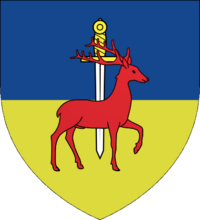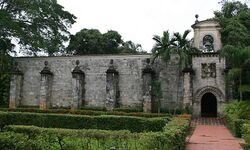Knights of Saint Misrav: Difference between revisions
mNo edit summary |
(Created page with "{{infobox military unit |unit_name = Knights of Saint Misrav<br><small>Brethren of the Sword of the Most Holy Order of Saint Misrav<br>''Karhaz ti'Hiyrim ti'Vedlan...") |
Revision as of 07:21, 19 January 2019
| Knights of Saint Misrav Brethren of the Sword of the Most Holy Order of Saint Misrav Karhaz ti'Hiyrim ti'Vedlan Kerfsara ti'Deker Misrav | |
|---|---|
 Arms of the Knights of Saint Misrav | |
| Active | 1026–1498 |
| Allegiance | Great Monastery of Ro'ekha |
| Type | Christian military order |
| Size | As many as 5,000 members, of which 800 were knights |
| Headquarters | Great Monastery of Ro'ekha, Ro'ekha |
| Patron | Saint Misrav |
| Colors | Blue and gold |
| Mascot(s) | A red buck with a sword |
| Engagements | Kur'zheti Crusades Azmiri Crusade |
| Commanders | |
| First Grand Master | Tairux of Beriyan |
The Brethren of the Sword of the Most Holy Order of Saint Misrav (Khadenz: Karhaz ti'Hiyrim ti'Vedlan Kerfsara ti'Deker Misrav), commonly known as the Misravic Order or Knights of Saint Misrav, were a knightly order in Cadenza, a branch of the Siresian Order based in the Great Monastery of Ro'ekha under the patronage of the Bishop of Ro'ekha. From its conception in the 1020s until its eventual disbandment in 1498, it waged its own crusades against the pagan Thaerine populations of nearby Kur'zhet and Azmir.
History
The Knights of Saint Misrav were founded at the request of the Bishop of Ro'ekha in 1026. They were to comprise the militant wing of the Order of Saint Siresius, the religious order in the Great Monastery of Ro'ekha, and protect it from rival powers such as the earls of Lemithri and Pammez in what was at times a highly fractious political environment. Notionally tied only to their abbot and monastery, from 1049 knights swore an oath of fealty to the bishop and in effect formed his own private army, though his influence was gradually diminished by further reforms over the following century.
The knightly brotherhood proved extremely popular, and at its height it had as many as 5,000 members of whom nearly one in five were Knights. In contrast, the Siresian Order itself had no more than 500 brothers in its main monastery and a further 800 throughout Cadenza, Kur'zhet and Azmir.
The main focus of the Knights of Saint Misrav was Kur'zhet, the larger island east of Cadenza where Saint Misrav himself had been stoned by a mob when attempting to evangelise. Inspired by the vitriolic rhetoric of religious and civil leaders, the order prosecuted holy war against the Thaerine Kur'zheti population. The 1288 Treaty of Canve saw an attempt by Kur'zhet to restrict the Knights' campaigns, but the order refused to be bound by its terms. Nevertheless, in 1302 the beginning of the Azmiri Crusade after the loss of Cadenzan Tyarz led to a gradual decline in their presence in Kur'zhet.
Organisation
The structure of the Knights of Saint Misrav was organised along similar lines to those of the Siresian Order, in a hierarchical chain. The areas in which they maintained a presence were divided into territories, each with a local Order Master who oversaw that territory's chapter houses. The territories included Cadenza, Brend (west Kur'zhet), Ai'zhet and Azmir. Each was subject to the order's Grand Master, who was usually also the Order Master of Cadenza.
Ranks
Members were broadly divided into two categories: Knights and Swordbrothers. The knights were often existing members of the nobility, but a swordbrother or prospective member could also be knighted by his Order Master. They were generally much more heavily armed and armoured than the swordbrothers, who fought as light infantry and occasionally light cavalry. Outside of combat, swordbrothers generally also provided most services required by the order, such as blacksmithing and building.

